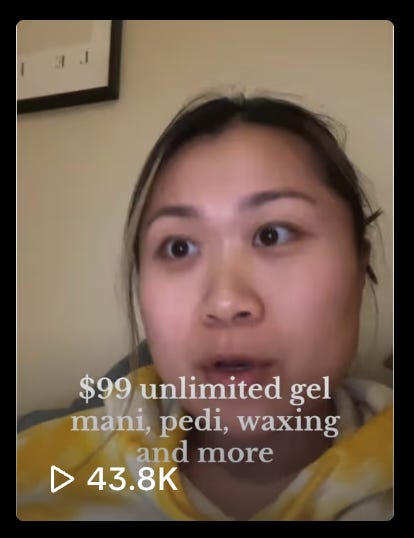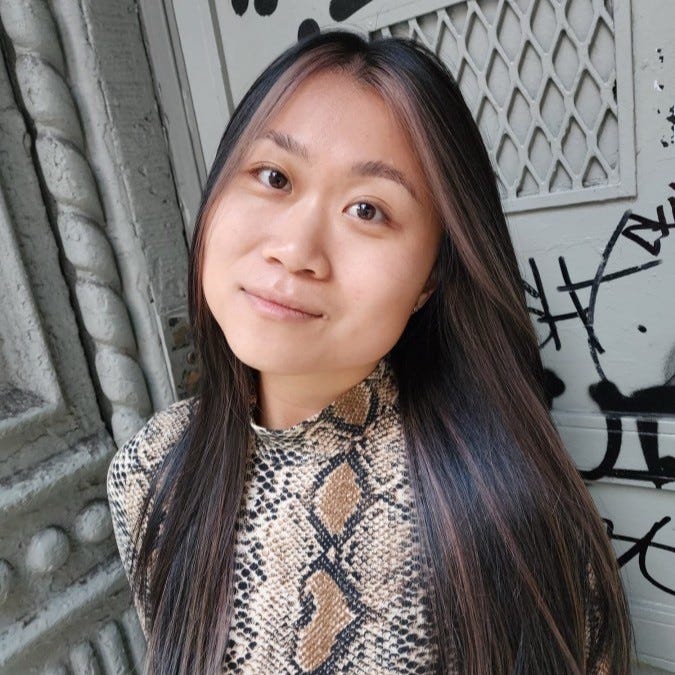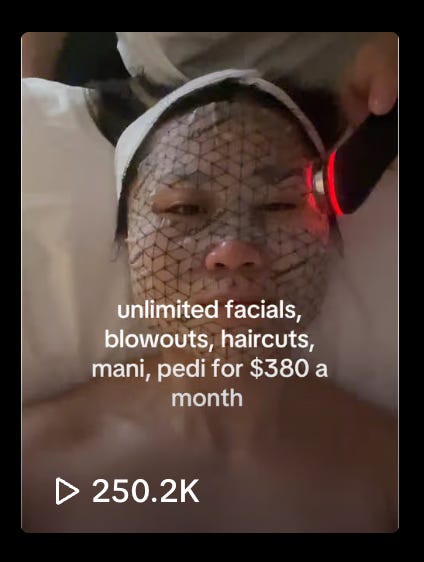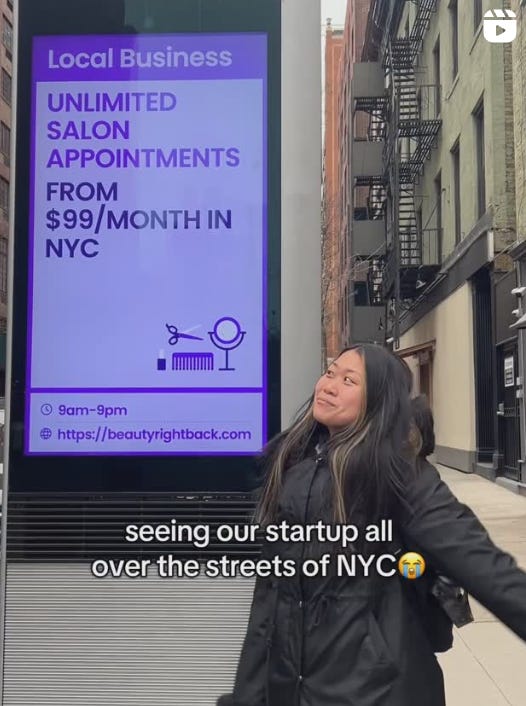- Braun & Brains
- Posts
- Brains: Beauty and the Budget
Brains: Beauty and the Budget
BeautyRightBack is self-care without the catch; unlimited treatments, no credit juggling, and salons actually benefit.
Braun & Brains is my personal outlet where I cover tech, business, and adjacent topics. Need production, insights, or a fresh perspective for your podcast or social media? Let’s talk.
I used to be a big ClassPass user. It was my go-to for booking workouts and the occasional beauty treatment, but like many, I started using it less as the weather got nicer. While searching for credit-free alternatives, I learned more about how the platform actually works for studios and salons, and it turns out it’s not such a great deal for them.
ClassPass brings in customers, but often at a steep discount for the business. Studios don’t set their own rates. ClassPass pays them a fraction of their normal price per booking, sometimes as little as a few dollars per class. Many studios use it to fill empty spots, but the second they have enough full-paying customers, they either cut down their availability or leave altogether. The result? Users see fewer of the best studios, and businesses struggle to stay afloat.
The more I thought about it, the more it bugged me. The best studios were the first to go, and the ones that stayed weren’t exactly thriving. It started to feel like I was gaming the system, but the system was rigged against the businesses I actually wanted to support.
Then I saw a TikTok from the cofounder of BeautyRightBack (BRB) talking about how the beauty industry is broken; not just for customers, but for salons too. It clicked. I wasn’t the only one feeling stuck in a cycle of overpaying, guessing on quality, and missing out on better options just because they weren’t on the platform I was using.

The TikTok that started it all for me!
On top of that, ClassPass had me locked into credit hell. I was constantly rationing my bookings, prioritizing what I could afford over what I actually wanted. There were so many amazing places I never even thought to try just because they weren’t part of the system.
Back in 2015, a New York Times article dug into ClassPass, a then-rising platform, and raised concerns about its sustainability for the studios that relied on it. Even then, the article noted that ClassPass paid studios less per class than their regular drop-in rates, making it hard to convert these users into long-term members.
The article also introduced a phrase I hadn’t heard before: the "digital middleman economy." This refers to a business model where tech companies act as intermediaries between consumers and traditional businesses; think Uber for transportation, Seamless for food delivery, and Amazon for retail.
We don’t live in a world where cutting out digital middlemen is always feasible. Life is expensive, and it’s only getting more so. Going straight to the source isn’t always the most affordable option. But it’s smart to start auditing our digital middlemen, including ClassPass. Are they treating the businesses on their platform fairly? Is this truly a win-win situation, or is someone losing out?
For example, many bed-and-breakfasts join Airbnb to attract more guests, even if Airbnb takes a cut. Sometimes, that tradeoff works. Other times, it doesn’t.
"In general, Silicon Valley likes to argue that middleman services offer customers, jobs, and opportunity where there were none before. O.K., sure. But that argument often glosses over the human costs associated with convenience."
Enter BRB, a subscription-based marketplace that gives you unlimited access to beauty services for a flat monthly fee. More importantly, it actually supports salons instead of squeezing them for discounts. BRB partners with top salons to provide a seamless experience while giving beauty professionals predictable income and long-term growth. AI-powered scheduling and personalized recommendations make it easier for both customers and salons to get what they need, without playing a pricing game.
Not every salon in your area will be available. Only the best ones will. So yes, you might have to walk a little farther to get your nails done, but that also means less gambling every time you book a beauty treatment with someone new. I’d rather get close to meeting my 10,000 steps for the day than spend money on a haircut that keeps me baseball-cap bound for the next month. With flexible plans starting at $99 per month, BRB is making beauty more accessible, one appointment at a time.

Think this is just ClassPass 2.0? I did too, but it’s not. It’s way better for service providers. BRB gives you unlimited beauty services for a flat fee with no credits and no guessing. Unlike ClassPass, which makes salons compete for discounted bookings, BRB guarantees steady income for businesses while using AI to streamline scheduling and personalize recommendations. Salons grow, customers save, and beauty gets a serious upgrade. It’s not just a booking app. It’s a better way to beauty.
I spoke with Odette Yang, co-founder of BeautyRightBack. A few days later, I ran into her at Alligator Lounge, the bar made famous by Nathan Fielder’s HBO show The Rehearsal. She had her laptop out at the bar. She was in founder mode. At the bar. I recommend both BRB and the show.
Small world, great conversation. Enjoy!

Odette Yang is the co-founder of BeautyRightBack, a platform offering unlimited mani, pedi, waxing, blowouts, and more starting at $99 a month.
Rachel: Hi! I'm here with the co-founder of BeautyRightBack. Can you tell us a little about your company and what you're building?
Odette: Yeah! We are building a double-sided marketplace for consumers. We offer unlimited, affordable beauty services through our partner network of salons, starting at $99 a month.
This means consumers can access unlimited hair, nail, waxing, and brow appointments. On the salon side, we provide a way for salons to generate recurring, reliable revenue. They gain access to an entirely new revenue stream while benefiting from predictability, visibility, and built-in customer loyalty. We’re connecting our loyal customer base with our partner salons, creating a win-win situation because consumers get affordable beauty services and salons get more foot traffic and higher profitability.
Rachel: How is BeautyRightBack different from ClassPass? What are some of the challenges salon owners face with ClassPass?
Odette: ClassPass and Groupon often come up when talking about salon solutions, but the problem with both is that they operate by selling discounts. Salons get paid pennies on the dollar for each appointment, making it unsustainable for them to continue accepting bookings through these platforms.
Also, ClassPass allows customers to jump between different salons. For example, if there are ten nail salons in SoHo, there’s nothing stopping a customer from trying a different one each time instead of building loyalty with one. That’s not beneficial for salon businesses.
We’ve heard from many salon owners that ClassPass only brings them one or two appointments a month, which doesn’t move the needle for their business. One salon owner told me, "I thought startups were supposed to be small, but you’ve given me more revenue and appointments in my first week with you than ClassPass did in six months." That speaks volumes.
Our approach is different. We only partner with one salon of each type per neighborhood. One nail salon, one hair salon, one waxing salon. This exclusivity helps drive customer loyalty and ensures salons get the recurring revenue they need to thrive.

Rachel: How do you ensure quality control as salons gain more traction? What if a salon’s service quality declines?
Odette: We have a 5 percent bonus pool that comes from customer subscriptions, and salons that maintain a 4.5-star rating or higher within our platform get a share of that bonus. This creates a financial incentive for them to consistently deliver excellent service.
We also reserve the right to remove salons from our platform. If we receive multiple complaints about cleanliness or service issues, we first communicate with the salon to understand what’s happening. If the issues persist and aren’t addressed, we remove them.
Rachel: How are you handling subscriber churn? Are people sticking with their memberships, or do you see a lot of users signing up for just a month before events like weddings and then canceling?
Odette: Our customers are actually really sticky. We offer every salon service imaginable, from haircuts and blowouts to pedicures and waxing, so there’s always a reason to use the membership.
Of course, some people cancel due to life changes like moving or losing disposable income, but overall, people recognize that our service is more affordable than paying per appointment. Beauty services are inherently recurring. Hair grows back, nails grow out, and waxing needs to be redone regularly. Because of this, most people realize that keeping their subscription is the best option.

Rachel: What inspired you to create BeautyRightBack? What made you realize this needed to exist?
Odette: I was working with salon owners on marketing and social media, and I noticed a huge gap. Billions of dollars have gone into salon back-office software. Companies like MINDBODY, Boulevard, GlossGenius, and others have built tools for scheduling and management, but none of these tools actually put people in salon chairs.
Salons were paying hundreds of dollars a month for software, but many weren’t making enough to pay themselves a salary. Some hadn’t taken a paycheck in five years, others were relying on family loans to cover rent, and many were struggling post-COVID. It was heartbreaking to see, and no one was truly helping them.
At the same time, beauty services have become unaffordable for many people. When I was fresh out of college, working in finance, I struggled to afford the same beauty services my coworkers got regularly. In New York City, prices have skyrocketed. If a haircut costs $150, people will start cutting their hair at home. But if they can get unlimited services for a reasonable monthly fee, they’re more likely to return to salons.
We realized that there was a huge untapped demand for beauty services. People weren’t skipping them because they didn’t want them but because they couldn’t afford them. Our model helps solve that problem.
Rachel: Where can people find you? And are there any expansion plans outside of New York City?
Odette: Right now, we’re live in New York City with salons in Manhattan and Brooklyn, and we’re expanding to Queens very soon. We’ve already started onboarding salons in two other cities, so stay tuned.
You can find us at beautyrightback.com to check out our membership tiers and salon locations. Our social handles are @GetThatBRB, and we’re launching our iOS app soon, which will make the experience even smoother.


Reply